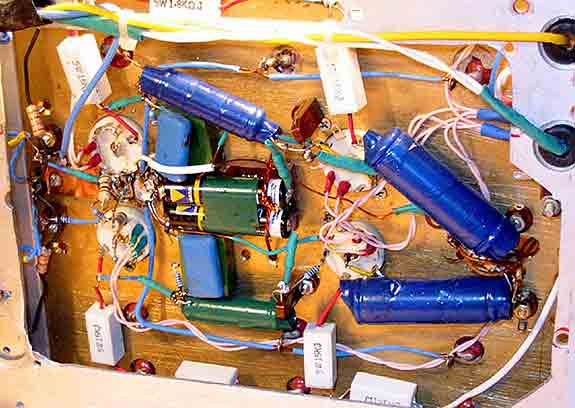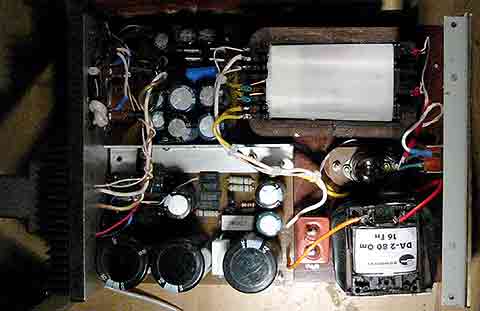Clauscorrector II. Stabilized tube preamp power supply (300 volts 50 milliamps + 6.3 volts 3 amps). Encyclopedia of radio electronics and electrical engineering

Encyclopedia of radio electronics and electrical engineering / Tube Power Amplifiers
 Comments on the article
Comments on the article

A simplified version of the Clauscorrector I in a two-block housing. The amplifying part itself repeats the clauscorrector I. Structurally, each block is an instrument box 180*240*100mm. Chassis board and front panels changed to 2mm brass. Here is such a cable salad under the chassis of the amplifier -

The power supply, in order to reduce the cost of time relays, etc., is made on a kenotron rectifier. 330V, 50mA and up to 3A of incandescent current are supplied to the load (one stabilized channel). In the amplifier block - an additional 120 microfarad filter (MBGO).

(click to enlarge)
- Option 1. The discrete current source (R4-R6, T2-T3) can be replaced by a 2-pin current source (Motorola 1N5294-1N5309).
- Option 2. Current source - we exclude, the circuit becomes a "capacitance multiplier"
The layout of the ground on the printed circuit board repeats what is shown in the diagram - there are two independent ground tracks on the PCB (not a star). The star is organized on the chassis, directly next to the output connector of the block (RP10-9) - the anode and filament earths, the screen and the negative output of the anode source are planted on it.

(click to enlarge)
With such switching, there is only one earth conductor (the filament current does not flow through it). The shield is not connected to the preamplifier chassis, only to the power supply chassis. Electrical contact between the PSU chassis and the preamplifier is not allowed.
Here is a sketch of the printed circuit board and its location in a case measuring 180 * 240 * 100 mm. TP125 power transformer and choke from Electron-Complex.

Power transistors in a fully insulated case are sandwiched between the board and the radiator - a piece of a corner 25 * 40 mm (in my version, the dissipation power is not more than 5W).
Publication: klausmobile.narod.ru
 See other articles Section Tube Power Amplifiers.
See other articles Section Tube Power Amplifiers.
 Read and write useful comments on this article.
Read and write useful comments on this article.
<< Back
 Latest news of science and technology, new electronics:
Latest news of science and technology, new electronics:
Machine for thinning flowers in gardens
02.05.2024
In modern agriculture, technological progress is developing aimed at increasing the efficiency of plant care processes. The innovative Florix flower thinning machine was presented in Italy, designed to optimize the harvesting stage. This tool is equipped with mobile arms, allowing it to be easily adapted to the needs of the garden. The operator can adjust the speed of the thin wires by controlling them from the tractor cab using a joystick. This approach significantly increases the efficiency of the flower thinning process, providing the possibility of individual adjustment to the specific conditions of the garden, as well as the variety and type of fruit grown in it. After testing the Florix machine for two years on various types of fruit, the results were very encouraging. Farmers such as Filiberto Montanari, who has used a Florix machine for several years, have reported a significant reduction in the time and labor required to thin flowers.
... >>
Advanced Infrared Microscope
02.05.2024
Microscopes play an important role in scientific research, allowing scientists to delve into structures and processes invisible to the eye. However, various microscopy methods have their limitations, and among them was the limitation of resolution when using the infrared range. But the latest achievements of Japanese researchers from the University of Tokyo open up new prospects for studying the microworld. Scientists from the University of Tokyo have unveiled a new microscope that will revolutionize the capabilities of infrared microscopy. This advanced instrument allows you to see the internal structures of living bacteria with amazing clarity on the nanometer scale. Typically, mid-infrared microscopes are limited by low resolution, but the latest development from Japanese researchers overcomes these limitations. According to scientists, the developed microscope allows creating images with a resolution of up to 120 nanometers, which is 30 times higher than the resolution of traditional microscopes. ... >>
Air trap for insects
01.05.2024
Agriculture is one of the key sectors of the economy, and pest control is an integral part of this process. A team of scientists from the Indian Council of Agricultural Research-Central Potato Research Institute (ICAR-CPRI), Shimla, has come up with an innovative solution to this problem - a wind-powered insect air trap. This device addresses the shortcomings of traditional pest control methods by providing real-time insect population data. The trap is powered entirely by wind energy, making it an environmentally friendly solution that requires no power. Its unique design allows monitoring of both harmful and beneficial insects, providing a complete overview of the population in any agricultural area. “By assessing target pests at the right time, we can take necessary measures to control both pests and diseases,” says Kapil ... >>
 Random news from the Archive Random news from the Archive AVR-DВ microcontrollers with three operational amplifiers
18.10.2020
A new series of general purpose microcontrollers from Microchip. The family belongs to the line of high-performance devices and is built on the basis of the AVR core, which can now operate at a frequency of 24 MHz over the entire supply voltage range. The series consists of 11 devices with memory sizes from 32 to 128 kB, in packages from 28 to 64 pins.
The series is designed to bring analog signal processing, real-time control, and multi-voltage support on a single board to areas such as industrial devices, home appliances, automotive, and the Internet of things.
For the first time in the history of microcontrollers with the AVR architecture, devices have three operational amplifiers, thanks to which it is possible to form gain stages and filtering functions without the use of external components. The analog peripheral set also includes a 12-bit differential ADC, a 10-bit DAC, three comparators, and analog zero-crossing detectors.
The innovative Multi Voltage I / O (MVIO) technology has been implemented, allowing UART, SPI or I2C to communicate with external devices operating at voltages other than the microcontroller supply voltage. Other advanced Microchip technologies are also applied, increasing the flexibility and reliability of the system.
The AVR128DB48 Curiosity Nano Evaluation Kit has been released to evaluate the capabilities of the new series.
Characteristics of microcontrollers AVR-DB:
Clock frequency up to 24 MHz;
Up to 128 KB Flash, up to 16 KB SRAM, 512 Byte EEPROM;
Up to three operational amplifiers;
12-bit differential ADC;
10-bit DAC;
Three analog comparators;
Up to three analog voltage zero crossing detectors - Zero Cross Detectors (ZCD);
Automatic Flash Integrity Check - CRCSCAN;
Configurable Logic Module - Configurable Custom Logic (CCL);
Event system supporting up to 10 channels;
Reference voltage module - Voltage Reference;
Serial interfaces: up to 6 x USART, up to 2 x I2C, 2 x SPI;
Microcontrollers are available in packages:
8 pins (SSOP, SOIC and SPDIP);
32 pins (VQFN and TQFP);
48 pins (VQFN and TQFP);
64 pins (VQFN and TQFP).
Supply voltage range from 1,8 to 5,5 V;
Operating temperature range from -40 to 125°C.
|
 Other interesting news:
Other interesting news:
▪ Diamond tells the origin of life
▪ Lite-On releases cameras for a third of laptops
▪ Cleaner in a freshly painted room
▪ Rain batteries
▪ Birds also have a cerebral cortex
 News feed of science and technology, new electronics
News feed of science and technology, new electronics
 Interesting materials of the Free Technical Library:
Interesting materials of the Free Technical Library:
▪ section of the site Factory technology at home. Article selection
▪ Cross out the article by Hero. Popular expression
▪ article Who wrote the song Was there a birch in the field? Detailed answer
▪ article Kitchen worker of the catering department. Standard instruction on labor protection
▪ article A simple battery discharge device. Encyclopedia of radio electronics and electrical engineering
▪ article Charger. Encyclopedia of radio electronics and electrical engineering
 Leave your comment on this article:
Leave your comment on this article:
 All languages of this page
All languages of this page
Home page | Library | Articles | Website map | Site Reviews

www.diagram.com.ua
2000-2024







 Arabic
Arabic Bengali
Bengali Chinese
Chinese English
English French
French German
German Hebrew
Hebrew Hindi
Hindi Italian
Italian Japanese
Japanese Korean
Korean Malay
Malay Polish
Polish Portuguese
Portuguese Spanish
Spanish Turkish
Turkish Ukrainian
Ukrainian Vietnamese
Vietnamese





 Leave your comment on this article:
Leave your comment on this article: